 |
Convert FLV to AMR
|
Total Audio MP3 Converter converts FLV files to AMR format.
The software is an all in one audio converter that supports more than 90 audio
and video files as input, and converts to popular formats such as MP3, WAV, AAC,
M4A, OGG, WMA, and AMR.
Total Audio MP3 Converter also supports batch conversion, and is full compatible
with Vista and Windows
7.
- Free Download
Total Audio MP3 Converter here and then install the software
by instructions
- Launch Total Audio MP3 Converter
- Choose FLV Files
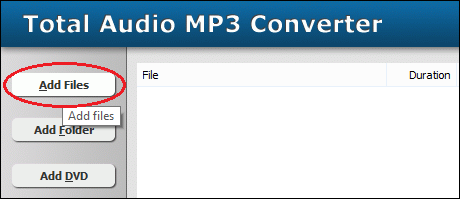
Click "Add Files" to choose FLV files and then add them to conversion
list.
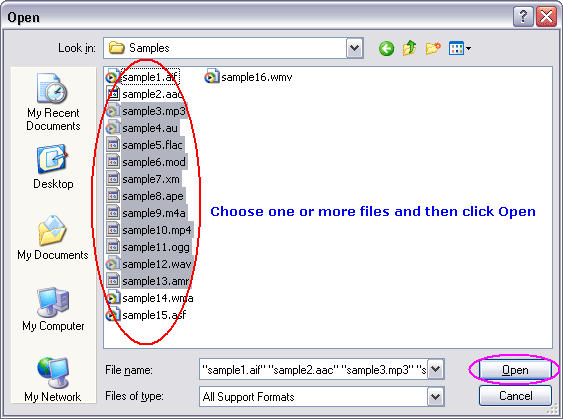
Choose one or more FLV files you want to convert and then click Open.
- Choose "to AMR"
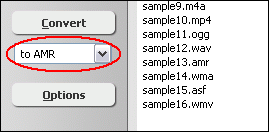
- Convert FLV to AMR

Click button "Convert" to convert all FLV files to AMR format.
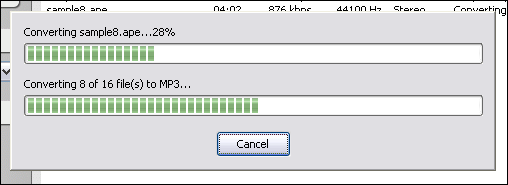
The software is converting FLV files to AMR format.
- Play & Browse
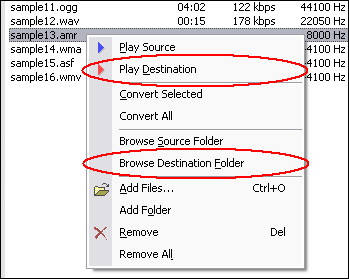
When conversion completes, you could right-click converted item and choose "Play
Destination" to play the destination file; or choose "Browse Destination
Folder" to open Windows Explorer to browse the destination file.
Top
What is FLV?
Flash Video is a container file format used to deliver video over the Internet
using Adobe Flash Player (initially produced by Macromedia) versions 6-10. Flash
Video content may also be embedded within SWF files. There are two different video
file formats defined by Adobe Systems and supported in Adobe Flash Player: FLV
and F4V. The audio and video data within FLV files are encoded in the same way
as they are within SWF files. The latter F4V file format is based on the ISO base
media file format and is supported starting with Flash Player 9 update 3.
The format has quickly established itself as the format of choice for embedded
video on the web. Notable users of the Flash Video format include YouTube, Google
Video, Yahoo! Video, metacafe, Reuters.com, and many other news providers. The
standards documentation for BBC Online deprecates the use of other formats previously
in use on its sites such as RealVideo or WMV.
Though the Flash Video container format itself is open, the codecs used with
it are patented. Flash Video FLV files usually contain material encoded with codecs
following the Sorenson Spark or VP6 compression formats. The most recent public
releases of Flash Player also support H.264 video and HE-AAC audio.
Flash Video is viewable on most operating systems, via the widely available
Adobe Flash Player and web browser plugin, or one of several third-party programs.
What is AMR?
Adaptive Multi-Rate (AMR) is an audio data compression scheme optimized for speech
coding. AMR was adopted as the standard speech codec by 3GPP in October 1998 and
is now widely used in GSM and UMTS. It uses link adaptation to select from one
of eight different bit rates based on link conditions. AMR is also a file format
for storing spoken audio using the AMR codec. Many modern mobile telephone handsets
will allow you to store short recordings in the AMR format. There also exists
another storage format for AMR that is suitable for applications with more advanced
demands on the storage format, like random access or synchronization with video.
This format is the 3GPP-specified 3GP container format based on ISO base media
file format.
Key Features:
- Sampling frequency 8 kHz/13-bit (160 samples for 20 ms frames), filtered to
200-3400 Hz.
- The AMR codec uses eight source codecs with bit-rates of 12.2, 10.2, 7.95,
7.40, 6.70, 5.90, 5.15 and 4.75 kbit/s.
- Generates frame length of 95, 103, 118, 134, 148, 159, 204, or 244 bits for
bit rates 4.75, 5.15, 5.90, 6.70, 7.40, 7.95, 10.2, or 12.2 kbit/s, respectively
- AMR utilizes Discontinuous Transmission (DTX), with Voice Activity Detection
(VAD) and Comfort Noise Generation (CNG) to reduce bandwidth usage during silence
periods
- Algorithmic delay is 20 ms per frame. For bit-rates of 12.2, there is no 'algorithm'
look-ahead delay. For other rates, look-ahead delay is 5 ms. Note that there is
5 ms 'dummy' look-ahead delay, to allow seamless frame-wise mode switching with
the rest of rates.
- AMR is a hybrid speech coder which uses Algebraic Code Excited Linear Prediction
(ACELP)
- The complexity of the algorithm is rated at 5, using a relative scale where
G.711 is 1 and G.729a is 15.
- PSQM testing under ideal conditions yields Mean Opinion Scores of 4.14 for
AMR (12.2 kbit/s), compared to 4.45 for G.711 (u-law)
- PSQM testing under network stress yields Mean Opinion Scores of 3.79 for AMR
(12.2 kbit/s), compared to 4.13 for G.711 (u-law)
Convert FLV to AMR Related Topics:
SWF to AMR,
WAV to AMR,
F4A to AMR,
WMD to AMR,
MTM to AMR,
OGX to AMR,
FLAC to AMR,
MPG to AMR,
SPX to AMR,
3G2 to AMR,
IT to AMR,
MJ2 to AMR,
VCD to AMR,
M2TS to AMR,
CD to AMR,
AMR to AAC,
ALAW to AMR,
OMA to AMR,
ULAW to AMR,
STR to AMR,
AMR to WAV,
MKA to AMR,
XA to AMR,
AC3 to AMR,
H264 to AMR,
HDTV to AMR,
VOC to AMR,
VQF to AMR,
MPGA to AMR,
AMV to AMR,
VFW to AMR,
AMR to OGG,
FLIC to AMR,
SMK to AMR,
AWB to AMR,
MP3 to AMR,
M4B to AMR,
EVO to AMR,
M2V to AMR,
SDP to AMR
|






